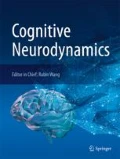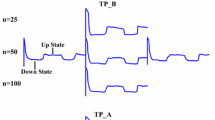Abstract
Spontaneous brain activities consume most of the brain’s energy. So if we want to understand how the brain operates, we must take into account these spontaneous activities. Up and down transitions of membrane potentials are considered to be one of significant spontaneous activities. This kind of oscillation always shows bistable and bimodal distribution of membrane potentials. Our previous theoretical studies on up and down oscillations mainly looked at the ion channel dynamics. In this paper, we focus on energy feature of spontaneous up and down transitions based on a network model and its simulation. The simulated results indicate that the energy is a robust index and distinguishable of excitatory and inhibitory neurons. Meanwhile, one the whole, energy consumption of neurons shows bistable feature and bimodal distribution as well as the membrane potential, which turns out that the indicator of energy consumption encodes up and down states in this spontaneous activity. In detail, energy consumption mainly occurs during up states temporally, and mostly concentrates inside neurons rather than synapses spatially. The stimulation related energy is small, indicating that energy consumption is not driven by external stimulus, but internal spontaneous activity. This point of view is also consistent with brain imaging results. Through the observation and analysis of the findings, we prove the validity of the model again, and we can further explore the energy mechanism of more spontaneous activities.







Similar content being viewed by others
References
Anderson J, Lampl I, Reichova I, Carandini M, Ferster D (2000) Stimulus dependence of two-state fluctuations of membrane potential in cat visual cortex. Nat Neurosci 3(6):617–621
Balasubramani PP, Chakravarthy VS (2020) Bipolar oscillations between positive and negative mood states in a computational model of Basal Ganglia. Cogn Neurodyn 14:181–202
Buzsaki G, Draguhn A (2004) Neuronal oscillations in cortical networks. Science 304(5679):1926–1929
Compte A, Sanchez-Vives MV, McCormick DA, Wang XJ (2003) Cellular and network mechanisms of slow oscillatory activity (< 1 hz) and wave propagations in a cortical network model. J Neurophysiol 89:2707–2725
Daneshi A, Azarnoush H, Towhidkhah F, Bernardin D, Faubert J (2020) Brain activity during time to contact estimation: an EEG study. Cogn Neurodyn 14:155–168
Déli E, Tozzi A, Peters JF (2017) Relationships between short and fast brain timescales. Cogn Neurodyn 11(6):539–552
Destexhe A, Mainen ZF, Sejnowski TJ (1994) Synthesis of models for excitable membranes, synaptic transmission and neuromodulation using a common kinetic formalism. J Comput Neurosci 1(3):195–230
Ermentrout GB, Terman DH (2010) Mathematical foundations of neuroscience, vol 64. Springer, Berlin
Fox MD, Raichle ME (2007) Spontaneous fluctuations in brain activity observed with functional magnetic resonance imaging. Nat Rev Neurosci 8(9):700–711
Golomb D, Amitai Y (1997) Propagating neuronal discharges in neocortical slices: computational and experimental study. J Neurophysiol 78(3):1199–211
Khajehpour H, Mohagheghian F, Ekhtiari H, Makkiabadi B, Jafari AH, Eqlimi E, Harirchian MH (2019) Computer-aided classifying and characterizing of methamphetamine use disorder using resting-state eeg. Cogn Neurodyn 13(6):519–530
Koch C, Segev I (1998) Methods in neuronal modeling: from ions to networks. MIT Press, Cambridge
Lampl I, Reichova I, Ferster D (1999) Synchronous membrane potential fluctuations in neurons of the cat visual cortex. Neuron 22(2):361–374
Laufs H, Krakow K, Sterzer P et al (2003) Electroencephalographic signatures of attentional and cognitive default modes in spontaneous brain activity fluctuations at rest. Proc Natl Acad Sci USA 100(19):11053–11058
Loewenstein Y, Mahon S, Chadderton P, Kitamura K, Sompolinsky H, Yarom Y, Häusser M (2005) Bistability of cerebellar purkinje cells modulated by sensory stimulation. Nat Neurosci 8(2):202–211
Mora-Sánchez A, Dreyfus G, Vialatte FB (2019) Scale-free behaviour and metastable brain-state switching driven by human cognition, an empirical approach. Cogn Neurodyn 13(5):437–452
Parga N, Abbott LF (2007) Network model of spontaneous activity exhibiting synchronous transitions between up and down states. Front Neurosci 1(1):57
Petersen CC, Hahn TT, Mehta M, Grinvald A, Sakmann B (2003) Interaction of sensory responses with spontaneous depolarization in layer 2/3 barrel cortex. Proc Natl Acad Sci 100(23):13638–13643
Raichle ME, Mintun MA (2006) Brain work and brain imaging. Annu Rev Neurosci 29(1):449–476
Schöller H, Viol K, Aichhorn W, Hütt MT, Schiepek G (2018) Personality development in psychotherapy: a synergetic model of state-trait dynamics. Cogn Neurodyn 12(5):441–459
Sen S, Daimi SN, Watanabe K, Takahashi K, Bhattacharya J, Saha G (2020) Switch or stay?: Automatic classification of internal mental states in bistable perception. Cogn Neurodyn 14(1):95–113
Steriade M, Nuñez A, Amzica F (1993) Intracellular analysis of relations between the slow (< 1 Hz) neocortical oscillation and other sleep rhythms of the electroencephalogram. J Neurosci 13(8):3266–3283
Wang Z, Rubin W (2014) Energy distribution property and energy coding of a structural neural network. Front Comput Neurosci 8:14
Wang R, Zhang Z, Chen G (2008) Energy function and energy evolution on neuronal populations. IEEE Trans Neural Netw 19(3):535–538
Wang R, Tsuda I, Zhang Z (2015) A new work mechanism on neuronal activity. Int J Neural Syst 25(03):1450037
Wang Y, Wang R, Xu X (2017) Neural energy supply-consumption properties based on Hodgkin–Huxley model. Neural Plast 2017:6207141. https://doi.org/10.1155/2017/6207141
Wang R, Wang Z, Zhu Z (2018a) The essence of neuronal activity from the consistency of two different neuron models. Nonlinear Dyn 92(3):973–982
Wang Y, Xu X, Wang R (2018b) An energy model of place cell network in three dimensional space. Front Neurosci 12:264
Wang Y, Xu X, Wang R (2018c) Intrinsic sodium currents and excitatory synaptic transmission influence spontaneous firing in up and down activities. Neural Netw 98:42–50
Wang Y, Xu X, Zhu Y, Wang R (2019) Neural energy mechanism and neurodynamics of memory transformation. Nonlinear Dyn 97(1):697–714
Xu X, Wang R (2013) Neurodynamics of up and down transitions in network model. In: Abstract and applied analysis, vol 2013, Article ID 486178
Xu X, Wang R (2014) Neurodynamics of up and down transitions in a single neuron. Cogn Neurodyn 8(6):509–515
Xu X, Ni L, Wang R (2016) A neural network model of spontaneous up and down transitions. Nonlinear Dyn 84(3):1541–1551
Xu X, Ni L, Wang R (2017) Synchronous transitions of up and down states in a network model based on stimulations. J Theor Biol 412:130–137
Xu Y, Ma J, Zhan X, Yang L, Jia Y (2019) Temperature effect on memristive ion channels. Cogn Neurodyn 13(1):601–611
Zheng HW, Wang R, Qiao L, Du Y (2014) The molecular dynamics of neural metabolism during the action potential. Sci China Technol Sci 57(5):857–863
Zheng H, Wang R, Qu J (2016) Effect of different glucose supply conditions on neuronal energy metabolism. Cogn Neurodyn 10:563–571
Zhu Z, Rubin W, Fengyun Z (2018) The energy coding of a structural neural network based on the Hodgkin–Huxley model. Front Neurosci 12:122
Acknowledgements
This work is supported by the National Natural Science Foundation of China (Nos. 11702096, 11802095, 11972159), the Natural Science Foundation of Shanghai (No. 19zr1473100) and the Fundamental Research Funds for the Central Universities (Nos. 222201714020, 22201814025). We also thank reviewers for comments on the manuscript to improve our work.
Author information
Authors and Affiliations
Corresponding author
Additional information
Publisher's Note
Springer Nature remains neutral with regard to jurisdictional claims in published maps and institutional affiliations.
Rights and permissions
About this article
Cite this article
Wang, Y., Xu, X. & Wang, R. Energy features in spontaneous up and down oscillations. Cogn Neurodyn 15, 65–75 (2021). https://doi.org/10.1007/s11571-020-09597-3
Received:
Revised:
Accepted:
Published:
Issue Date:
DOI: https://doi.org/10.1007/s11571-020-09597-3




